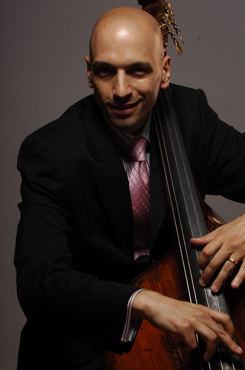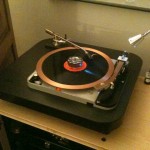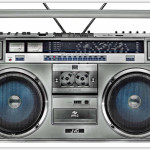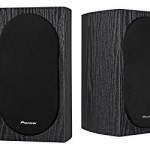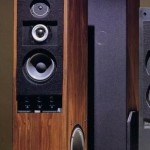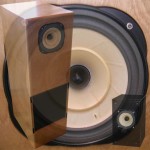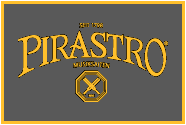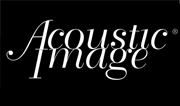The Importance of Critical Listening — Part 2
A little while ago I talked about why it’s important to sit down and listen to music, not just have music playing in the background of your life (The Importance of Critical Listening Part 1). I also eluded to the fact that listening to mp3 downloads aren’t going to help you develop your tone. In this blog post, I’m going to tell you about a few ways to improve the sound of music in your life!
DISCLAMIER
First thing’s first. Whatever I am about to say in this article, please know that the MOST important thing is LISTENING! I’m a bit of a dork in that I like to take things apart and tinker. I used to build cars, but now I build stereos and turntables.That’s just my thing. However, even if you can’t afford (or don’t have the patience to assemble) a “fancy” system, DO NOT WORRY. Sit down in front of whatever you have and listen- enjoy the moment!.
Okay, that said, here’s a little information to get you started if you want to geek out. Oh, I should add another disclaimer.
DISCLAIMER No. TWO
This article is by NO means the end–all of hi-fi information. There will be tons of holes in my gear lists, limitless combinations of good sounding gear, and very one-sided opinions of what I feel is a good idea. But hey, it’s MY blog, so there.
Now, on with the show.
To Mp3 or Not to Mp3
Let me put something to rest. I used to be one of the people who said “Mp3 is good enough for me. I just need to hear the information, I don’t care about ‘audiophile’ sound.” Boy was I wrong. I believe that people need to be listening to at least CD quality files. Why? Let me tell you a story.
I have a friend who runs a jazz program at a very nice private high school in my area. He was wondering why the drummers were putting duct tape on their cymbals and electric bass players were playing staccato and thumpy. When I looked at his audio system in the band room I immediately saw that he was streaming mp3’s from a laptop into an cheap mixing console. It made Philly Joe Jone’s cymbals sound dull and lifeless, which is what the kids were trying to imitate (thus the tape on the cymbals)! Ug. What that system did to Paul Chamber’s beautiful tone is unmentionable. Needless to say, we teamed up and got the school something respectable to listen to. Now the students are hearing a much better representation of what the old masters sounded like back in the day. The last time I popped into the band room I didn’t see any tape on the cymbals.
As I mentioned in part 1 of this series, I started out on vinyl when I was a kid. I made the switch to cassette tapes, then onto CDs in college, which I noticed didn’t sound as good as my vinyl records but I wasn’t soo bothered at the time. CDs were convenient. With the arrival of the Apple iPod and iTunes came the mp3, which was the epitome of convenience. I was sold immediately.
For those who think CD is perfect sound, they’re forgetting that the creator of the CD acknowledged the fact that the CD was imperfect- it was a compromise. Norio Ohga of Sony demanded that a CD be able to hold all of Beethoven’s 9th symphony (read the whole article here: http://gizmodo.com/5729864/why-the-cd-is-74-minutes-long). To accomplish this, some frequencies needed to be left out. Of course, some people say that these frequencies are beyond the range of human hearing. However, you and I know that musicians aren’t exactly normal humans. We can hear the difference.
So, the CD is already a compromise. Then along comes the MP3. Talk about a compromise! Due to the expense of large hard drives (at the time) and lack of any kind of decent high speed internet (at least in our country), the Motion Pictures Expert Group (MPEG) developed a lossy format for audio. “Lossy” means exactly what you think it means. It means that you lose information. An audio digital file has, in a nutshell, two types of information- file information that the PC needs and the actual music information. Let’s say one track from a CD, which would either be a WAV file or an AIFF file, is 63mb. If you convert it into an mp3, the file size gets shrunken drastically to something under 10mb. Hmmmm, what do you think that does to the sound of your favorite John Coltrane recording?
Okay, this is actually a pretty big discussion that I covered in more detail in a blog posts titled “My New Music Store – What is HD Audio?” and “Vinyl vs CD – It’s a Battle to the Death!.” Let’s move on to what YOU can do about your listening situation.
Get Your Hi-Fi On!
No one system or method of listening is going to work for every reader. We have people in houses or apartments, people with roommates or wives and children, people with lots of money and people with no budget. Let’s agree on one thing- sound quality is the most important thing. From there, I’ll just talk about a few things that I’ve personally had experiences with and you can make your own decision about what works for you.
Here’s how a listening system breaks down. In case you’re not familiar with the terminology, I’ll keep this very basic:
Source player. This is what plays the music. It can be a CD player, a turntable, a computer, an iPhone, etc…
Pre-amplifier. This is something that takes the signal from the source and boosts the strength of that signal to what we call “line level”. That’s a relatively standard signal strength that a power amplifier can use to amplify further and send the sound signal to speakers or headphones. Most preamps have things like a volume control, extra inputs so you can plug your CD player, turntable, TV, etc… into it for control.
Power amplifier. This is a piece of equipment that takes the line level signal from the preamp and boosts the heck out of it and blasts it though speakers or headphones.
Speakers. Well, we all know what speakers are. They can be bookshelf models, giant floor standing boxes, or simple headphones. Yes, headphones are in fact speakers that you wear on your head.
Those are the basic elements. You also need to know what a DAC is. DAC stands for Digital to Analog Converter, and it does exactly what you think. It takes the 1’s and 0’s from a CD or hard drive and converts them into an analog electric signal that can travel through your RCA wires into your preamp and on to your headphones or speakers. If you’re going to be using a turntable, then your preamp needs to have a specific Phono Preamplifier. Why? Two reasons. One, the signal from a turntable is very weak, so it needs a lot more boosting compared to a CD player, and two, there is a very special RIAA EQ curve that needs to be applied to the signal before it is sent to the preamplifier (Here’s a WIKI page entry that explains the RIAA curve). If your preamp doesn’t have a phono input, don’t worry. You can buy a stand alone phono pre and plug it into an open input on the back of your preamp just like a CD player or other component.
Examples of Things You Probably Already Own
If you have a radio with a built in CD player, that device has a Source player, DAC, preamp, power amp, and speakers all built into one (aka a boom box, as we used to call them back in the 1500’s, LOL).
If you plug your computer into a boom box using a stereo 1/8th inch mini cable, then your computer is acting as the source player and DAC, and the boom box is acting as the preamp and power amp. Same thing if you plug your iPhone into the boom box. The iPhone is the source and DAC.
Okay, so that’s basically what all the pieces are. Here are some options for listening nirvana!
Headphone Listening
Let’s talk about the path of least resistance- headphone listening. If you are reading this, I am assuming that you have a computer. At the very least you can buy a good set of headphones. There are companies that make great in-ear earbuds, but you have to spend a lot of money to get a decent pair. For less money you can buy a really excellent set of large, ugly, “over the head” style of headphones. Personally, I highly recommend the best pair of Grado headphones that you can afford.
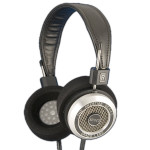 Their entry level Grado 60i headphones ($80) are great! However, I found a pair of their 325i headphones for $150 on the used market and have never looked back. They’re $349 if you want to buy them new. I’ll have these headphones for the rest of my life. Not only do I use them for my stereo or computer occasionally, I also take them into the studio when I record. They’re “open canned”, which means that they hardly block out any room sound. They’re not the best headphones if you are in a noisy environment. They almost feel like you’re listening to speakers in a room.
Their entry level Grado 60i headphones ($80) are great! However, I found a pair of their 325i headphones for $150 on the used market and have never looked back. They’re $349 if you want to buy them new. I’ll have these headphones for the rest of my life. Not only do I use them for my stereo or computer occasionally, I also take them into the studio when I record. They’re “open canned”, which means that they hardly block out any room sound. They’re not the best headphones if you are in a noisy environment. They almost feel like you’re listening to speakers in a room.
You can get a great pair of Grado headphones, plug them into your computer, and you’ll be on your way. So, where do you think the weak link in that signal chain is? Yep- the computer DAC. Computers manufacturers do not go out of their way for audio sound. Unless you have personally installed a fancy-schmancy sound card into your computer, your build in computer DAC kinda stinks.
At home I have three DACS. I recently picked up a tiny USB DAC called the Audioquest Dragonfly ($150) . Simply plug it into your computers USB port, tell the computer to route all of your audio through it, and plug your Grado’s into it. This is a really good sounding DAC, however it’s limited to USB connectivity only.
If you plan on building a system eventually, you may want to start with a full feature DAC that offers more connectivity. For this I recommend a Cambridge DAC Magic. I bought a used one years ago for around $200 for my downstairs system. It has multiple inputs, including a USB option for a computer. My third DAC is something called the Xciter made by Cary Audio. At $1500, it’s relatively high end and sounds great, but there is a LOT of competition for DACs above the $1000 price point.
So, there you have it. Good headphones and a good DAC connected to your PC will give you great sound, and it’s great for apartment dwellers that like to listen to speed metal at 3am. That said, make sure you re-rip all of your CDs using the Apple Lossless code or FLAC formats so that you are not compressing the audio. Better yet, buy your favorite albums at 96K-24bit digital files- twice the resolution of CDs and most likely the exact bit rate that the music was originally captured in if it was recorded after 1998 or so. You can find almost any recording at HD Tracks.com. Refer to the articles I posted above to learn more about HD audio.
Expanding on this idea, you can take it one step further and ditch the computer in favor of something called a headphone preamplifier. You would plug your source (CD player, iPhone, iPad, computer,) into your DAC, then run an analog cable from the DAC to the headphone preamplifier. A dedicated headphone preamp will do a much better job feeding your headphones a good signal. Some headphone preamps even come with tubes to further give you an audiophile experience. I’ve never used a dedicated headphone preamp, but even a simple well built one (probably between $50 to $100) would be a step up from simply using a computer to DAC to headphone signal path. There is an excellent website if you want to dig deeper into this journey called Head-Fi.org. Create a user account and troll the forums. I’m sure there are many people out there just like you who are curious about where to start.
Rewire your Brain
The one issue with headphone listening is that pesky internal organ known as the brain. Apparently, the brain processes information differently when listening through headphones as opposed to speakers. So, while I do in fact recommend headphone listening, I prefer to do all my serious listening in front of a good set of speakers.
So, up until this point, we’ve talked about DACs, source components, and a tiny bit about preamps. Now, let’s talk about how to send power to a pair of speakers. Prices start to go up, but you don’t have to mortgage your house (although doing so will get you a nice stereo. Just sayin’). Here is my recommendation for the absolute CHEAPEST system that sounds pretty dang good.
DISCLAMIER NO. 3
Positioning is everything. You can have $40,ooo speakers but if you place one speaker on a bookshelf four feet off of the ground facing right at you and the other one pointing slightly across the room into the corner, well, they’re going to sound like $100 speakers. That said, an inexpensive pair of speakers, thoughtfully placed in a room, can sound outstanding.
Speakers are the tough element to find on a budget. As I’ve said, there are great deals on the used market. However, there is one brand new pair of speakers that I read about over and over again in Stereophile magazine that I just had to check out- the horribly named Pioneer SP-BS22-LR, which are astoundingly low priced at $127 on Amazon. That’s right. I said one hundred and twenty seven dollars, with FREE shipping if you’re an Amazon Prime member. The name may make them sound cheap, but these speakers are definitely not B.S. They were designed by the audio legend Andrew Jones who also designed TAD’s flagship Evolution One speakers, which will set you back $29,800.00 a pair if you’re interested.
I couldn’t believe how good these $127 speakers sounded. Hit a garage sale and look for an old Onkyo, Marantz, Pioneer, or Sony stereo on the cheap, then plug these speakers into it. Place the speakers about three feet off of the ground and about four feet apart, then sit about four feet in front of them. (rule of thumb: the tweeters should be at ear level when you’re seated in front of the speakers). You will be very happy. If you want to be happier, use a decent DAC to get the music into the whatever preamp you are using.
Those speakers sound really good, but you can start climbing the audiophile tree of life by looking for used speakers from the 70’s, 80’s and 90’s. Here are some great brands to look for: Spendor, Advent, AR (Audio Research), Klipsch Heresy, Vandersteen, and Signet just to name a few. I have a pair of Spendor SP1’s that sound amazing. They’re quite possibly the last pair of speakers you’ll ever want to buy, and you can find them cheap if you’re lucky since they really don’t look like much. If you’re not lucky, well, you can still find them for around $500. A mint pair with the original stands would be around $1K.
I recently acquired a pair of AR9 speakers. They’re HUGE! With two 12″ side firing woofers in each speaker, they are what you call “full range”, meaning that they’ll dig deep and pump out the low notes (below 35hz) of church organs and such. Generally, you can find them between $500-$800 depending on their condition. However, they’re soo big and heavy I wouldn’t be surprised if you could get them for free if you’re willing to carry them out of someone’s house.
Klipsch Heresy speakers are still in production, but you can find used pairs from the 1970s for around $200. The best thing about these speakers is that they are very efficient speakers, which means that you don’t need a super powerful amplifier to drive them.
If you are a handy person, you can make your own speakers. You can buy a pair of full range drivers from Commwnsenseaudio.com and build the cabinets yourself (something I did recently and I love them!). They’ll provide the speaker cabinet blueprints for free. The neat thing about full range drivers is that you don’t have to worry about tweeters and crossovers– one speaker covers the entire frequency range. This type of speaker is especially good at jazz and classical music, and you don’t need a lot of power to drive them.
That brings us to something that you should be aware of- matching a power amplifier to your speakers. As I mentioned, Heresy’s and the Common Sense Audio speakers are what they call “easy to drive”, which means that they are very efficient due to their design. However, the AR9s are NOT efficient.
That said, I’m not going to bother you with this right now. Remember, we are not trying to blow the roof off of the house. We want to hear clear, beautiful music. How loud do you want to listen to Giant Steps anyway? We’re not building a party system, we’re building a listening system. My Spendor SP1’s are not efficient, yet they sound amazing being powered by my 12 watt tube power amp. Only 12 watts!
So, that’s all I’m going to say about power amps and speaker efficiency. This blog is just here to help you get rolling. Once you’ve caught the bug, you’ll learn about all the gory details on your own.
Preamps and Power Amps
Here’s where things get tricky. People and companies have been building preamps and power amps for over 70 years. There is a huge list of great components that you can find on the cheap, let’s say $100 or under. I can’t even begin to recommend everything, but I can get you started.
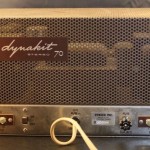 Here is my first rule of thumb when looking over garage sale items. If you are looking at a stereo that’s older than 1980 and it appears to be made really well to your eyes, then it most likely is a good piece of gear. For example, if you are looking at a preamplifier that has a really nice brushed aluminum faceplate with nice knobs that feel good when you turn them, well, that is probably a very good preamplifier. If it’s under $50, take a chance on it! However, if it’s made entirely of plastic with cheap push buttons, then it’s probably a budget–entry level piece of gear that may or may not sound very good. If you already have something at home that works, I’d pass over the plastic stuff.
Here is my first rule of thumb when looking over garage sale items. If you are looking at a stereo that’s older than 1980 and it appears to be made really well to your eyes, then it most likely is a good piece of gear. For example, if you are looking at a preamplifier that has a really nice brushed aluminum faceplate with nice knobs that feel good when you turn them, well, that is probably a very good preamplifier. If it’s under $50, take a chance on it! However, if it’s made entirely of plastic with cheap push buttons, then it’s probably a budget–entry level piece of gear that may or may not sound very good. If you already have something at home that works, I’d pass over the plastic stuff.
When I hit garage sales or flea markets, I keep an eye out for a few brands: McIntosh, Fisher, Sansui, and NAD, just to name a few off of the top of my head. Mostly, though, I look at anything that might have the signs of being quality made. Then it’s all a matter of price. Under $100, I might just try it for the fun of it. Of course, the closer it is to $100, the more likely I am to pull my iPhone out and Google it!
Solid State Vs. Tube
Personally, I prefer tube gear. I do own a beautiful sounding solid state amplifier made by the Digital Amplifier Company (a Cherry Plus) that I will most likely never sell, but currently both of my main systems sport tube power amplifiers. That is a personal preference. There are great sounding solid state amps, and there are great sounding tube amps. My recommendation is to try both types at some point in your hi-fi life! There is no rule against having two power amplifiers sitting side by side in your stereo system and switching between them ever other day. Heck, I’ve been doing that for the last two months with two different integrated tube amps. Why not? It’s fun and it keeps me sitting in front of my stereo listening to great music!
Here’s another rule of thumb. When you’re sifting through stuff at garage sales and flea markets and you come across a stereo component that has tubes in it, pick it up if the price is right. In general, I’m going to bet that you will love the sound of any tube gear from the 1960’s-1970’s! I just listened to an old friends’ Magnavox console stereo that he bought new in 1961. Wow! Even with the original tubes (and ZERO visits to any service shop for general maintenance in the last 50 years) it sounded very nice. That brings me to a very important issue.
Old tube gear can be dangerous! I don’t want to scare you. By all means you SHOULD be buying old tube gear, in my opinion, but make sure that you find a tech/repair shop in your area. You will want to have a qualified technician look things over before you plug it in. Generally speaking, anything more than 20 years old will need to have the power supply capacitors replaced (to be safe) and a few resistors replaced. Resistors will “drift out of spec,” as they say, which will affect the tone. This kind of work usually isn’t that expensive, and if it’s a nice piece of gear, it’s TOTALLY worth it!
Of course, chances are you’ll need to find tubes at some point. There is only one person on the planet that I’ll recommend– Jim McShane. Drop him a line and tell him what piece of gear that you’re looking to re-tube and he’ll tell you what you need. His prices are great and he won’t steer you wrong. Tell him I sent you!
Phone A Friend
I emailed a few audiophile friends to see what they have to say about the low end. I addition to being amazing musicians, they both have more than one amazing system in their house. Like me, they’re always searching for the next secret audio artifact that sounds amazing yet won’t break the bank. Here’s what they have to say about entry level components to look out for.
Billy Drummond
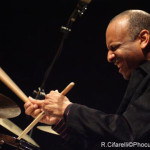 Speakers :Insignia NS-B21111 Coaxial @ Way Bookshelf . I paid $35 new a few years back. Not sure what the price is. Sold at Best Buy!
Speakers :Insignia NS-B21111 Coaxial @ Way Bookshelf . I paid $35 new a few years back. Not sure what the price is. Sold at Best Buy!
Lepai Tripath T-Amp: $25 from Parts Express
Dynex DVD player- $26 (Best Buy)
Now using a used pair of Klipsch SB-2 Speakers. Different than the Insginia but not really better. Horn vs Coax (Tannoy type). I still have the Insignia
This is my kitchen system and when listening to it while cooking etc it’s very enjoyable. Clean as a whistle. Less than $100.
Other alternatives: some powered speakers that allows one to connect to a digital source, phone, iPod, hard drive etc, but that’s cheating as those items cost considerably more.
Watch Craigslist.org– You can buy used receivers, speakers, cd players for really cheap. I’ve found cd players, dvd players for $10!!!!! Receivers for $35. There’s a guy out here in Jersey who specializes in that stuff. refurbishes speakers, receivers and then resells for profit but still really good deals. Bought a pair of Infinity RS-4000 with Emit tweeter for $125 with a re-done crossover. Killer!! He’s also who I got the Klipsch speakers from for $65.
Bob DeVos
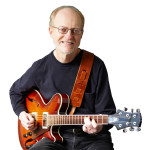 As far as garage sale shopping I would recommend looking out for tube integrated amps or receivers by Fisher, Scott, Sherwood and Dynaco gear. I have a Fisher X100 integrated that sounds great. Fisher receivers like the 500-C are great finds.
As far as garage sale shopping I would recommend looking out for tube integrated amps or receivers by Fisher, Scott, Sherwood and Dynaco gear. I have a Fisher X100 integrated that sounds great. Fisher receivers like the 500-C are great finds.
Solid state receivers Like the old Pioneer SX line are good finds. I have an SX-650 that I got for free driving my Vandersteens right now until I put my Mac amps back in the system, I was doing some McShane updates to the power amp. The SX-650 sounds fine although it isn’t enough power optimally for the Vandys (Vandersteen speakers). I know someone who picked up an SX-1250 for less than $100.
Sansui AU series integrateds like the AU-9900, AU-9500. Check out http://www.sansui.us/Amplifiers.htm
Final Thoughts
Well, I’ve given you a lot to think about. Let me give you some links to read:
Audiokarma.org– and great forum that has an amazing number of knowledgable people that frequently post. If you have a question, I guarantee you’ll find the answer there.
I already mentioned Head-fi.org for all your headphone needs.
Vinylengine.com– This is THE website for turntables. They have instruction manuals for just about every turntable and tonearm ever made, as well as a great forum.
The audio section of soundfountain.com has some informative articles that have come in handy.
Craigslist.org or eBay– obviously two great places to watch for gear when you know what you’re looking for. Craigslist especially, since most people that sell there are willing to negotiate and you get to meet the seller and inspect (or hear) the items before you pay.
TheAnalogdept.com is a really great site for various tips and tricks. In particular, you simply have to make a set of their DIY speaker cables made out of Home Depot indoor-outdoor extension cable. Start there if you are on a tight budget.
On that note, I have to say that cables make a huge difference in a system. You have RCA cables, speaker cables, digital cables, etc… and they do affect the sound. It’s not a matter of bad cables not helping the sound– bad cables will ruin the sound. At the very least you need a decent quality cable to not interfere with the signal path. You will hear a difference.
I highly recommend ANY cable from Analysis-Plus! Watch for high quality used cables, or buy the new entry level ones. They’re all great. I use their cables exclusively– all the RCAs, Speaker, digital, and power cables for two stereo systems and all my XLR, guitar cables, and amp power cords for my bass career. That took my systems from sounding good to sounding great!
Of course, I’ve spent years experimenting, swapping, rebuilding, buying, selling, borrowing, modifying… It’s a fun hobby that, unlike golf, will actually improve your musicianship in the long run.









